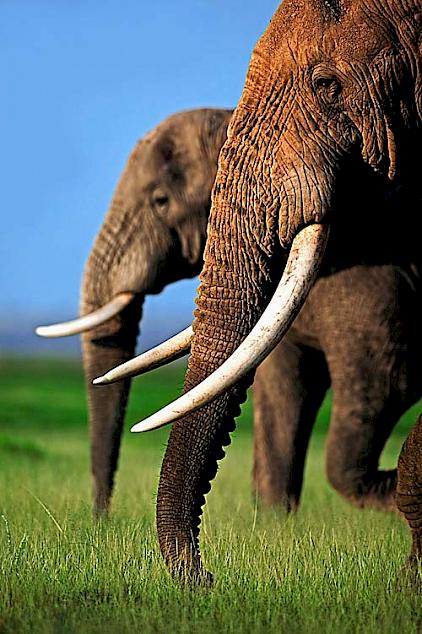Few surprises in latest CITES Proposals, but sparks may fly
Gland, Switzerland, 26th October 2009—the Secretariat of CITES (the Convention on International Trade in Endangered Species of Wild Fauna and Flora) has today revealed most of the list of just over 40 proposed changes in CITES trade rules that will be discussed along with a range of other policy and implementation issues at the forthcoming Conference of the Parties taking place next March in Qatar (CoP15).

CITES CoP meetings occur every three years and changes to trade rules, through amendments to the CITES Appendices can have profound conservation implications for affected species. The listing of a species in Appendix I effectively prevents all commercial international trade, while those listed in Appendix II can be traded under special permit conditions.
Proposals for the CoP15 include species familiar in CITES debate, like the African Elephant, some that were rejected at the previous meeting (CoP14) in The Hague, Netherlands in June 2008 and a number of new issues for consideration by member countries.
Sure to be controversial is a proposal by Kenya, supported by several other African governments, that they hope would block any attempts by other countries to gain CITES endorsement of further legal ivory sales before at least 2028. The same proposal also aims to put an end to the currently approved legal export of carved ivory items from Namibia and Zimbabwe by tourists.
In conflict with this proposal are requests from Zambia and Tanzania to transfer their African Elephant populations from Appendix I to Appendix II in order to allow one-off sale of government-owned ivory stockpiles.
“The conflicting aims of the Kenyan-led and Tanzania / Zambia proposals are certain to create tension and deep divisions,” said Steven Broad, Executive Director of TRAFFIC International. “We hope that a satisfactory conclusion can be reached that serves the best interests of conservation and that the discussion does not detract from the key problems causing the poaching of elephants, such as the lack of control over illegal domestic ivory markets.”
Also likely to be controversial are proposals to list several marine species in the Appendices.
Top of the list will be Atlantic Bluefin Tuna. Monaco is proposing an Appendix I listing, putting a stop to further commercial trade. The issue has already caused controversy within the European Union, with France’s President Nicolas Sarkozy publicly announcing his support for a commercial fishing ban, but his government then opposing it during a close vote that saw European Union Member States fail to reach the necessary majority to support Monaco’s proposed ban.
Sharks too are sure to cause a stir. At the previous CoP meeting, proposals to list Porbeagle and Spiny Dogfishes in the Appendices were narrowly defeated following strong lobbying by the fishery industry and deep divisions between the CITES Secretariat and the United Nations’ Food and Agriculture Organization about criteria for deciding in what circumstances CITES should play a role in regulating trade in marine species. Both species are once more being proposed for Appendix II listing. The US is also proposing listing a further six shark species, including three hammerheads in Appendix II.
“We can only hope that discussion of these proposals is focused on the critical issues they involve in terms of conservation and international fisheries management,” commented Broad.
“CITES has a key role to play in complementing other conservation and management measures—at national and international levels—for commercially important marine resources.”
“The failure to list Spiny Dogfish and Porbeagle Sharks in 2007 was especially disappointing, but this time we hope that conservation arguments will prevail over institutional politics and that CITES member countries will cut through the rhetoric and look at the hard facts of the problems facing the future of these fisheries if they fail to act now.”
In a similar category are corals, used principally for making jewellery, which were initially accepted for inclusion in Appendix II in June 2007 only for the decision to be narrowly overturned in plenary.
Several Proposals relate to reptiles and amphibians, such as one to downlist certain populations of Nile Crocodile to Appendix II, to reflect the improved conservation status of this species. By contrast, Kaiser’s Spotted Newt has been put forward for Appendix II listing, because of concerns over its levels in trade, as has the Ornate Dabb Lizard, which Israel has proposed is listed in Appendix I, to end its commercial international trade.
The majority of proposals relating to plants concerns Malagasy species being put forward for Appendix II listing.
Brazil is also proposing an Endangered species of Rosewood tree—Aniba rosaeodora—is listed in Appendix II. The species has seriously declined because of over-exploitation for rosewood oil extraction.
TRAFFIC and programme partner IUCN will undertake full analyses of each of the proposals, to investigate whether they meet the appropriate biological and other criteria. Based on these analyses, TRAFFIC will be preparing its Recommendations on Proposals to Amend the Appendices, which will be made available prior to the Meeting.
This will be the first CITES CoP to be held in the Middle East, and TRAFFIC hopes that an additional outcome of the meeting will be greater attention to the need for enhanced regional enforcement co-operation in the region.
The proposals are not the only items on the CoP meeting agenda. There will also be important discussions based on documents submitted in advance of the meeting relating to Tigers, elephants, rhinos and species like the Humphead Wrasse.



